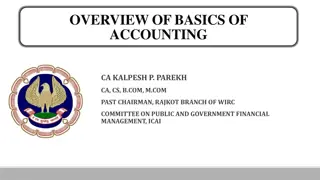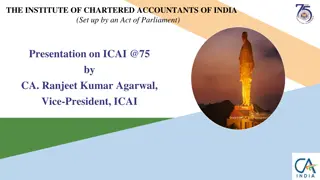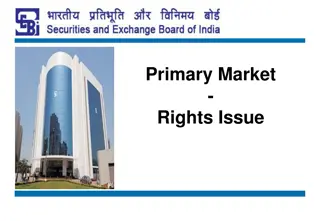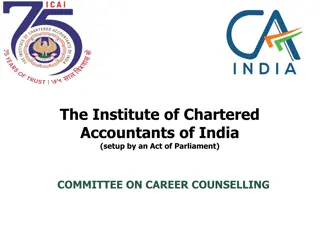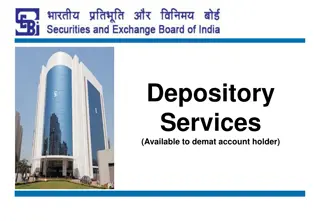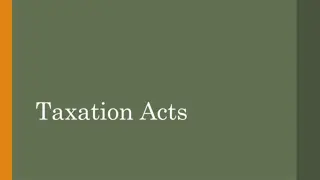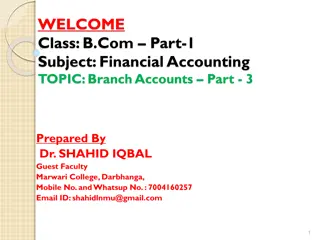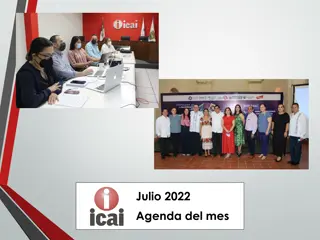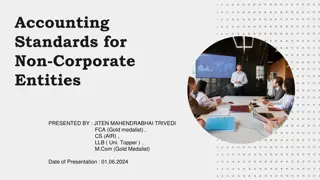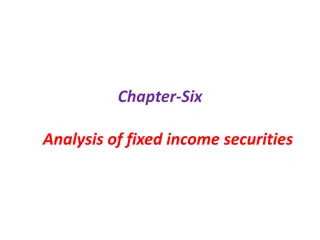Accounting and Taxation of Securities Organized by Belgaum Branch of ICAI
Explore the accounting treatment and taxation of securities in a seminar organized by the Belgaum branch of ICAI. Learn about various types of securities, their accounting principles, taxation rules, and important points through case studies and insightful discussions led by CA Kinjal Shah. Gain valuable insights into securities regulations and understand the nuances of different investment vehicles in the market.
Download Presentation

Please find below an Image/Link to download the presentation.
The content on the website is provided AS IS for your information and personal use only. It may not be sold, licensed, or shared on other websites without obtaining consent from the author.If you encounter any issues during the download, it is possible that the publisher has removed the file from their server.
You are allowed to download the files provided on this website for personal or commercial use, subject to the condition that they are used lawfully. All files are the property of their respective owners.
The content on the website is provided AS IS for your information and personal use only. It may not be sold, licensed, or shared on other websites without obtaining consent from the author.
E N D
Presentation Transcript
Accounting and Taxation of securities -Organized by Belgaum branch of SIRC of ICAI February 23, 2024 By CA Kinjal Shah (B.Com., FCA, DISA(ICAI), M.Com., CAMS)
CONTENT What are Securities? Types of securities Accounting treatment Taxation of securities Case studies Other important points 2
Section (Regulation) Act, 1956: Securities include Shares, scrip s, stocks, bonds, debentures, or a pooled investment vehicle Derivative; units or instrument issued by collective investment scheme; Mutual fund units; Pool investment vehicle units or instrument; 2(h) of Securities Contracts 4
Section (Regulation) Act, 1956: any certificate or instrument which possesses any debt or receivable Government securities; rights or interest in securities; Such other instruments as may be declared by the Central Government to be Securities 2(h) of Securities Contracts Securities" shall not include any scrip or instrument with insurance in-built in the product. 5
Securities covered Equity shares Mutualfunds Exchange traded funds (ETFs) Debt securities Gold securities Real estate investments (REITs) Infrastructure investment trusts (INVITs) Derivatives 7
Equity Shares Ownership units in a company Represent a claim on company assets and profits Traded on stock exchanges Prices fluctuate based on supply, demand, and company performance 8
Mutual Funds Pooled collection of assets that invests in stocks, bonds, and other securities Mutual Funds invest in various asset classes such as Equities, Debt, or a combination of different asset classes. Can be classifiedas - Equity MutualFunds - Debt MutualFunds - Hybrid Mutual Funds. Taxation rules of Mutual Funds differ based on the underlying investments 9
Exchange Traded Funds (ETFs) Similar to Mutual Funds as they have pooled investments but can be traded on stock exchanges like Equity shares. Currently the types of ETFs traded in India Index ETFs, Sectoral ETFs and Gold/Silver ETFs. Index ETFs track the movement of indices such as the SENSEX or the NIFTY. Sectoral ETFs invests solely in stocks from a specific sector or industry such as Technology funds. 10
Debt securities Represent a loan between an issuer (borrower) and an investor (lender) Investors received periodical interest on debt securities Debt securities can be listed or unlisted Examples of listed Debt securities are debentures, Government Securities, corporatebonds, tax-freebonds, etc Examples of unlisted debt securities are Non-convertible debentures, debt securities raised through private placements 11
Gold Securities Currently, there are multiple ways to invest in gold, even though traditionally, the physical form has been most popular. Gold is also purchased as financial products such as digital gold, Gold ETFs, Gold Mutual Funds, and Sovereign Gold Bonds. 12
Real Estate Investments Real Estate investments refers to real property that consists of land and improvements, which include buildings, fixtures, roads, structures, and utility systems. In recent years, another type of Real Estate investment has gained significant popularityin India. These are Real Estate Investment Trusts or REITs. At present, there are two key types of REITs available in India Listed REITs and Unlisted REITs. REITs are companies that own, operate, and manage income- generating real estate assets. REITs pay investors in various forms such as interest, dividend, loan repayment. 13
Infrastructure Investment Trusts (Invits) A type of investment vehicle that allows investors to invest in infrastructure assets such as roads, bridges, power plants, and renewable energy projects. Listed on stock exchanges, and investors can buy and sell units in them just like they would buy and sell shares of stock. Invits pay investors in various forms such as interest, dividend, loan repayment. 14
Derivatives Derivatives are financial instruments* whose value depend upon or is derived from some underlying assets. The underlying assets can be real assets such as commodities, gold etc. or financialassets such as index, interest rate etc. A derivative does not have its own physical existence. It emerges out of the contract between the buyer and seller of the derivative instrument *Financial Instruments means any contract that gives rise to a financial asset of one entity and a financial liability or equity instrument of another entity. 15
Types of Derivatives Forwards Futures Options Swaps 16
Forwards Holder is charged to perform the contract. Forwards are not traded on stock exchanges. They are available over-the-counter (OTC) and are not market-to-market. Example: A farmer plans to grow 5000 Kgs of wheat this year. He can sell his wheat for whatever the price is when he harvests it, or he could lock in a price now by selling a forward contract that obligates him to sell 5000 kgs of wheat to a company after the harvest for a fixed or specified price. By locking in the price now, he can actually eliminate the risk of falling wheat prices. 17
Futures Standardized agreement: Buy or sell an asset (commodity, stock, etc.) at a predeterminedprice on a specific future date. Binding obligation: Both parties must fulfill the contract, ensuring commitment. Exchange-traded: Contracts are bought and sold on regulated stock exchanges. Equity Futures are cash settled or delivery setled but index futures are always cash settled Example: Purchasing a June futures contract for XYZ stock at Rs. 1,000 per share means buying/selling at that price on the designated date in 18 June.
Futures - Illustration Example Date of Transaction Contract Specification Contract Price 12/04/2023 NIFTYFUTApr23 Rs. 3,500/- 200 5 (1000 Units of NIFTY) 10% Rs.3,550/- Rs.3,470/- Rs.3,600/- Market Lot (No. of Units) No. of Contracts Bought Initial Margin Price as on close of 12/04/2023 Price as on close of 13/04/2023 Position Squared off on 14/04/2023 Initial margin: On 12/04/2023: Mr. Bull to pay Initial Margin of Rs.3, 50, 000/-., i.e. 10% (1000 x 3500) Mark to Market: On 12/04/2023 Mr. Bull to receive Rs.50, 000/-, i.e. 1000 (3550 3500). On 13/04/2023 Mr. Bull to pay Rs.80, 000/-, i.e. 1000 (3550 3470). On Squaring up of the Contract: Mr. Bull will receive Rs.1,30,000/-i.e. 1000(3600-3470). Actual gain in the transaction Rs. 1,00,000-i.e. 1000(3600-3500) 19
Options Contracts that give the buyer a right to buy and/ or sell the underlying asset at the specified price during a particular period of time. The buyer of the contract has a right but not an obligation to perform as per the terms of the contract. For acquiring this right the buyer has to pay Option Premium to the seller/writer. The seller has the obligation to buy or sell the specified underlying asset at an agreed price if the buyer chooses to exercise the option. For this he charges the OptionPremium from the buyer/holder. 20
Options Strike/Exercise Price: The price at which the buyer has a right to buy or sell an underlying asset and the seller has an obligation to sell or buy. There are two types of options: Call Option and Put Option A call option is a right to buy an underlying asset or contract at a fixed price at a futuredate but at a price that is decided today. A put option is the right to sell an underlying asset or contract at a fixed price at a futuredate but at a price that is decided today. 21
Options The rights and obligations of the parties involved in an option contract can be summarized in a tabular form, as under: Option Call Buyer/Holder Right but not an obligation to buy the underlying asset Seller/Writer Obligation but no right to sell the underlying asset. Put Right but not an obligation to sell the underlying asset Obligation but no right to buy the underlying asset 22
Options - Illustration Example- Purchase of Put option by Mr. Bear Date of transaction Contract specification Strike price Market lot (No. of units) No. of put options bought Premium on 12/04/2023 Price as on last day of settlement (Expiry date: 27/04/2023) 12/04/2023 TCSApr23 Rs. 2,050/- 200 5 (1,000 shares of TCS) Rs. 20/- per unit I Rs. 2,100/- II Rs. 1,900 Price as on 25/04/2023 (i.e., before expiry) Rs. 2,000 Selling price (Premium receivable) as on 25/04/2023 Rs. 25/- per unit 23
Options - Illustration As Mr. Bearer is the buyer of the put option, he has the right but not an obligationto sell the underlying asset Scenario I - Purchase of Put option by Mr. Bear and squareup before contract expiry On 12/04/2023: Put Premium Payableby Mr. Bear - Rs.20,000/-i.e. 1000* Rs.20/-. Sale on 25/04/2023(Before expiry): Assumed Mr. Bear will squareup his Put Option on 25/04/2023 i.e., before expiry Net gain to Mr. Bear Premium received Less Premium paid for the purchase of Put Option i.e Rs.5,000/-{Rs. 25,000(-) Rs.20,000/-}. 24
Options - Illustration Scenario II - Purchase of Put option by Mr. Bear and squareup on contract expiry On 12/04/2023 : Put Premium Payable by Mr. Bear - Rs.20,000/- i.e. 1000 * Rs.20/-. On 27/04/2023: I TCS Price is Rs.2,100/- - Assumed that Mr. Bear will not exercise the Put Option. Mr. Bear will incur a maximum loss of Rs.20,000/-i.e. the amount of premium paid. II TCS Price is Rs.1,900/-- Mr. Bear will exercise his Put Option and will receive Rs.1,50,000/-{ 1000(2050-1900)} On settlement: Net gain to Mr. Bear - Profit on settlement of Put Option Less Premium paid for the purchase of Put Option i.e Rs.1,30,000/- {Rs.1,50,000(-) Rs.20,000/-}. 25
Options - Illustration In the above example suppose Mr. Bull is the seller of the above-referred Put Option at the same premium for the same strike price and for the same series. From the following tabulation the net position of profit/loss for both Mr. Bear (Buyer of Put Option) and Mr. Bull (Seller of Put Option) at different levels of price of TCS on the settlement date viz.27th April 2023 can be assessed. Price of TCS as on 27th April 2023 (Maturity) Mr. Bear (Buyer of 1000 Put Options) Profit/(Loss) (20000) Mr. Bull (Seller of 1000 Put Options) Profit/(Loss) 20000 2150 2100 (20000) 20000 2050 (20000) 20000 2000 30000 (30000) 1950 80000 (80000) 1900 130000 (130000) 26
Swaps Two parties exchange their financialobligations under this contract. Cash flows are based on a principal amount agreed by both the parties without exchanging the principal. The amount is based on a rate of interest. While one cash flow remains fixed, the other changes based on the benchmark rate of interest. Swaps are OTC contracts between businesses and/ or financial institutions and are not traded on stock exchanges. 27
Accounting treatment as per AS 13 AS 13 deals with accounting for assets held as Investments. Classification of Investments 1.Current Investments Intended to be held for less than a year from the date when such investment is done Carried in the books at lower of cost or market price. If there is any reduction in the carrying amount than the cost the same should be debited to profit and loss account as diminutionin the value of investments. 29
Accounting treatment as per AS 13 2. Long-Term Investments Investments other than the current investments Carried in the books at cost. If there is any permanent decline in the value of investments the same will have to be recognized. However a lenient view can be taken for investments held of a strategic nature 30
Accounting treatment as per AS 13 Disposal On disposal of current/long term investments: the difference between the carrying amount and the proceeds on disposal net of expenses, if any should be recognized in the profit and loss account. 31
Accounting treatment as per AS 13 Reclassification of investments From long term to current: Transfer to be made at lower of cost and carrying value on the date of such transfer. From current to long term: Transfer to be made at lower of cost and fair value on the date of such transfer. 32
Accounting treatment as per AS 13 Disclosures in the FinancialStatements: The below mentioned are the disclosures in the financial statements with respect to AS 13 Accounting for Investments is applicable: (a) accounting policies employed for determining carrying amount of investment (b) the amounts which are included in the profit and loss statement for: (i) Dividends, interest, and rentals on the investments presenting the income from such long-term and current investments separately. Gross income must be stated, amount of TDS (tax deducted at source) included under the Advance Taxes Paid. (ii) Profits and losses on the disposal of current investment and the changes in carrying the amount of the investment 33
Accounting of Derivatives Guidance note by ICAI All derivative contracts should be recognised on the balance sheet and measured at fair value. If any entity decides not to use hedge accounting, it should account for its derivatives at fair value with changes in fair value being recognised in the statement of profit and loss Fair value represents the exit price i.e. the price that would be paid to transfer a liability or the price that would be received when transferring an asset to a knowledgeable, willing counterparty. 34
Accounting of Derivatives Example - Mr. Bull buys 1000 units NIFTY Future April 2023 expiry, at a price of Rs. 3500/- on 28th March 2023. Initial marginis 10% Daily Settlement price of this unit were as under: Date Daily Settlement price MTM Receivable/ (Payable) [(Daily settlement price Contract price)*units] Cumulative gain/(loss) 28/03/2023 3,550 50,000 50,000 29/03/2023 3,525 25,000 75,000 30/03/2023 3,460 (40,000) 35,000 31/03/2023 3,480 (20,000) 15,000 01/04/2023 Market closed - 15,000 02/04/2023 Market closed - 15,000 03/04/2023 3,575 75,000 90,000 35
Accounting of Derivatives Date Particulars Debit Amount Credit amount 28/03/20 23 At the inception of the contract Future contract asset a/c Dr To Stock broker a/c (Margin = Rs.3,500*1,000 units*10%) 35,000 35,000 31/03/20 23 Open Interest as on Balance sheet Date Stock Broker a/c Dr To MTM (P&L) a/c 15,000 15,000 03/04/20 23 On expiry Stock Broker a/c Dr Bank a/c Dr 20,000 90,000 To Futures contract asset a/c To MTM (P&L) a/c 35,000 75,000 36
Accounting of Derivatives On 31/03/23 Open interest Future contract asset will appear under Current asset 37
Accounting of Derivatives Sample contract note:
Accounting of Derivatives Explanation of contract note: B/F and C/F in the remarks column indicate that these are previous day s positions and that the position has not been squared off. Net total (before levies) Rs. 48,500 and Rs. 21,440 is the mark to market. Payin/ payout obligation (Net total) - Rs. 27,060 is the net mark to market for the specific date.
Accounting of Derivatives (IND AS 109) As per IND AS 109: Classification: Derivatives to be classified as Financial liability or financial asset. Measurement: All derivatives are measured at fair value with changes in fair value being recognized in profit and loss for the period, except derivatives that qualify as hedging instruments. Fair value of a financial instrument is a combination of its intrinsic value and time value. In a fair and perfect market, it would be inappropriate to conclude that immediately at the inception of a contract, it results in creation of rights and obligations for two independent parties i.e. the contract has no intrinsic value at inception 40
Equity shares Listed Shares Domestic Equity Unlisted Domestic Equity Shares STCG for shares held < 24 months. Tax rate: As per slab rate of the investor LTCG tax rate: 20% with indexation. STCG for shares held < 12 months. Tax rate: 15%. Long-Term Capital Gains (LTCG) for shares held 12 months. Tax rate: 10% Exemption: Rs. 1,00,000 Foreign Equity Shares STCG for shares held < 24 months. Tax rate: As per slab rate of the investor LTCG tax rate: 20% with indexation. 42
Mutual Funds A) Equity Mutual Funds: They invest 65% or more of their investable assets assets such as domestic Equity shares STCG for shares held < 12 months. Tax rate: 15%. Long-Term Capital Gains (LTCG) for shares held 12 months. Tax rate: 10% Exemption: Rs. 1,00,000 (B) Debt Mutual funds: Debt Mutual Funds invest in Debt instruments such as bonds, T-bills, Certificates of Deposits, NCD. G-Sec, overnight call and money market etc. in Equity-oriented Bought till 31/03/2023 STCG for investments held < 36 months. Tax rate: As per Slab rate of the investor LTCG if held 36 months Tax rate: 20% with indexation. Bought after 31/03/2023 Taxed as STCG irrespective of holding period 43
Mutual Funds (C) Hybrid Funds Equity Allocation< 35%: Taxed like Debt MutualFunds. Equity Allocation 65%: Taxed like Equity MutualFunds. Equity allocation between 35%-65%: Taxed at 20% with indexation 44
ETFs (A) Equity ETFs - Majorly invest in equities or related investment instruments. STCG for ETFs held < 12 months. Tax rate: 15%. Long-Term Capital Gains (LTCG) for ETFs held 12 months. Tax rate: 10% Exemption:Rs. 1,00,000 (B) Gold and Debt ETFs Bought till 31/03/2023 STCG for investments held < 36 months. Tax rate: As per Slab rate of the investor LTCG if held 36 months Tax rate: 20% with indexation. Bought after31/03/2023 Taxed as STCG irrespective of holding period 45
Debt securities (B) Instruments STCG for investments held < 36 months. Tax rate: As per Slab rate of the investor LTCG tax rate: 20% without indexation. Unlisted Debt (A) ListedDebt Instruments STCG for investments held <12 months. Tax rate: As per slab rate of the investor LTCG tax rate: 10% without Indexation. 46
Gold securities (B) Sovereign Gold Bonds Tax-free individuals. If exited before maturity. STCG if held < 36 months. Tax rate: Slab rate. Long-Term (LTCG) if held 36 months. Tax indexation indexation Exemption: Rs. 1,00,000 Interest taxed as Income from other sources at slab rate (A) Gold ETFs, Gold Mutual Funds Bought till 31/03/2023 STCG for investments held < 36 months. Tax rate: As per Slab rate of the investor LTCG if held 36 months Tax rate: 20% with indexation. at maturity only for Capital Gains rate: 10% or without with 20% Bought after 31/03/2023 Taxed as STCG holding period irrespective of 47
REITs and Invits Interest and rental income : Taxed at applicable slab rate. Dividend income : If u/sec 115BAA of Income Tax Act, 1961, the REIT s/Invit s Special Purpose Vehicle has: 1. Not opted for the lower tax regime Dividend is exempt 2. Opted for the lower tax regime - Taxable at the applicable tax slab rate for unit holder At the time of sale of reits/invits -STCG for REITs/Invits held < 36 months. Tax rate: 15%. -Long-Term Capital Gains (LTCG) for REITs/Invits held 36 months. Tax rate: 10% Exemption: Rs. 1,00,000 48
REITs and Invits Loan repayment i.e., return of capital must be reduced from the cost of acquisition at the time of sale of unit by the investor for computation of capital gain. Loan repayment in excess of issue price will be taxed as Income from other sources at applicable slab rate 49
Derivatives The income from Derivatives instruments should be taxed as Business income according to assessee s income tax slab It is irrespective of the frequency or volume of derivatives transactions. The business income is normally divided into speculative and non- speculative income. 50


